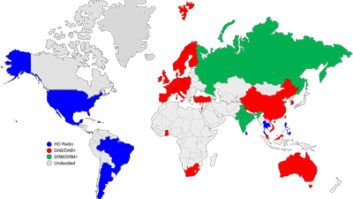
Our ongoing series of articles and opinions about AM radio’s business outlook continues to generate plenty of interest. The latest responses are to a commentary by Scott Taylor in the Jan. 1 issue; I suspected his observations might trouble some people but I felt they were too important not to share.
Taylor has visited a number of AMs while doing contract engineering work; he wrote that he has visited multiple mom-and-pop stations that are “limping along,” essentially operating on little more than a “whole lot of wishing and hoping that things will improve.”
Based on what he’s seen, Taylor feels some owners are “delusional” about the value of their small-market AM stations. He also has heard from several who were considering simply turning in their licenses or selling for the value of their land.
* * *
One reader took strong issue with Taylor’s conclusions, describing him with a term I won’t repeat:
“The [individual] who wrote ‘AM, Losing Its Grip on Reality’ needs to talk to those of us who continue to be meaningful in the community and profitable. It takes determination, creativeness and persistence but it is being done.”
I invited this reader to tell us more about his own success stories; he said he’d consider.
A different kind of reaction came from a man in New Jersey, who wrote: “Just wanted to say great editorial on AM!
“We’re looking into the possibility of buying an AM in southern New Jersey/Pennsylvania and have been dumbfounded by what owners are asking for their stations,” he said. “They’re thinking someone is going to pay a ton of money for their AMs, and that’s not going to happen … not in this market and not any time soon … probably never.
“Thousand-watt AM stations in my opinion are probably worth not much more than the land they sit on, even in fairly populated areas. The world has changed,” he continued. “We’re looking to buy, but it’s got to be at a price that’s a steal.”
For this reader, “delusional” valuations for AMs are part of a larger problem:
“The truth is, no matter how much the economic cheerleaders talk up the notion that the recession is over, the evidence dictates that more and more people are being foreclosed on, business is drying up, radio will never have the same viability, China continues to gain the advantage on manufacturing and our political leaders have no idea how to turn this country around (which would be to force every multinational corporation to come back to America).”
This would-be broadcast licensee concludes: “Radio — and America, for that matter — are in for a tumultuous ride.”
* * *
Meanwhile, our friend and vocal reader Jerry Arnold, DOE for Midwest Communications/WPRS(AM) in Terre Haute, Ind., offered a more detailed reaction to the article.
“Yes, as Scott Taylor says, there are many small mom-and-pop stations on the verge of bankruptcy. Some have put themselves into that position. But I also know of many that are doing quite well.”
Jerry wanted me to know about a station for whom he does occasional contract work, WNDI(AM/FM).
“Sullivan is your quintessential one-horse town in southwest Indiana, population around 5,000. The AM is a 250 Watt station and the FM is a 3,000 Watter.
“John and Teresa Montgomery, who bought this combo a few years back, run it as a business all by themselves. He does most of the sales work, the programming — much of which is live and local — and most of the announcing and voice work. She does the billing and office work.
“They were able to pay off the note on the two stations, including real estate, in less than 10 years,” Jerry says. “Their spot loading is nearly maxed out months in advance on both stations. And while he doesn’t have a brand-new super whizbang board, it is a quite serviceable one, for which parts, if they’re necessary, are still available.”
And don’t assume that due to their rural location, no other city-grade signals appear on AM or FM in Sullivan. Jerry says at least 10 FM stations and five AMs in nearby cities blanket Sullivan.
“To me, one of the biggest mistakes many small-market stations make, regardless if they are AM or FM or both, is to try to run the station as automated as possible,” Jerry believes.
“On initial investigation, it looks attractive due to the lack of human (read: paid) interaction that is required. But as has been proven time and time again, that alleged benefit is rarely realized for several reasons.”
He cites the cost of acquiring an automation system and what he believes is its “pre-determined point of obsolescence” as well as “the ‘turn-off’ factor of the listeners who want to be able to know they are listening to some guy at the radio station, and possibly contact them. This cannot be over-stated.
“When listeners tune out for this reason, so do sponsors, and there starts the ‘domino effect,’ which will inevitably lead to the bankruptcy about which we have already spoken.”
Jerry concludes: “So in a way, Scott Taylor is correct, except he should rewrite the title of his article to ‘Broadcasters Losing Their Grip on Reality,’ and note my reasons why. One more time for those who have missed my many articles on this subject in the past: It’s not the medium, it’s the message.”
Thanks to all who continue to comment on this topic.
I’ve posted the articles in our series about AM, as well as reader commentaries, in one place so you can review them easily. They are atwww.radioworld.com/article/92680.











